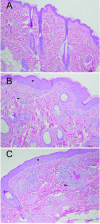Alopecia in Rhesus macaques correlates with immunophenotypic alterations in dermal inflammatory infiltrates consistent with hypersensitivity etiology
- PMID: 20102458
- PMCID: PMC2862887
- DOI: 10.1111/j.1600-0684.2010.00402.x
Alopecia in Rhesus macaques correlates with immunophenotypic alterations in dermal inflammatory infiltrates consistent with hypersensitivity etiology
Abstract
Background: Although alopecia is a commonly recognized problem affecting many captive Rhesus macaque colonies, there is no consensus as to the underlying etiology or appropriate course of management.
Methods: We performed skin biopsies to assess underlying pathology in alopecic Rhesus macaques and performed immunohistochemical and metachromatic staining of these biopsies to assess the cellular infiltrates.
Results: Alopecia is associated with superficial dermal perivascular mononuclear cell infiltrates and skin pathology consistent with chronic hypersensitivity dermatitis. The inflammation is primarily composed of CD4+ cells admixed with histiocytes and mast cells. Inflammation is correlated with degree of alopecia. Further analysis in different groups of macaques revealed that animals born outdoors or infected with lung mites had reduced dermal inflammatory cell infiltrates and a lower incidence of alopecia.
Conclusions: These findings support a hypothesis that an altered housing status resulting in decreased pathogen burden in Rhesus macaque colonies may contribute to dermal immunophenotypic alterations and subsequent development of dermatitis with resultant alopecia.
Figures


Similar articles
-
Psychogenic alopecia in rhesus macaques presenting as focally extensive alopecia of the distal limb.Comp Med. 2011 Jun;61(3):263-8. Comp Med. 2011. PMID: 21819697 Free PMC article.
-
Coat condition, housing condition and measurement of faecal cortisol metabolites--a non-invasive study about alopecia in captive rhesus macaques (Macaca mulatta).J Med Primatol. 2006 Feb;35(1):3-11. doi: 10.1111/j.1600-0684.2005.00141.x. J Med Primatol. 2006. PMID: 16430489
-
Dermatologic investigation of alopecia in rhesus macaques (Macaca mulatta).J Zoo Wildl Med. 2005 Jun;36(2):229-38. doi: 10.1638/04-054.1. J Zoo Wildl Med. 2005. PMID: 17323563
-
Alopecia: possible causes and treatments, particularly in captive nonhuman primates.Comp Med. 2009 Feb;59(1):18-26. Comp Med. 2009. PMID: 19295051 Free PMC article. Review.
-
Histopathology of Cutaneous Inflammatory Disorders in Children.Pediatr Dev Pathol. 2018 Mar-Apr;21(2):115-149. doi: 10.1177/1093526617748781. Pediatr Dev Pathol. 2018. PMID: 29607753 Review.
Cited by
-
A simple alopecia scoring system for use in colony management of laboratory-housed primates.J Med Primatol. 2014 Jun;43(3):153-61. doi: 10.1111/jmp.12107. Epub 2014 Feb 27. J Med Primatol. 2014. PMID: 24571509 Free PMC article.
-
Fatty acid supplements improve hair coat condition in rhesus macaques.J Med Primatol. 2017 Oct;46(5):248-251. doi: 10.1111/jmp.12271. Epub 2017 May 2. J Med Primatol. 2017. PMID: 28464359 Free PMC article.
-
Alopecia in three macaque species housed in a laboratory environment.Am J Primatol. 2014 Apr;76(4):325-34. doi: 10.1002/ajp.22236. Epub 2013 Nov 14. Am J Primatol. 2014. PMID: 24243351 Free PMC article.
-
Effects of Pregnancy, Outdoor Access, and Antifungal Medication on Hair Loss in Breeding-age Female Pigtailed Macaques (Macaca nemestrina).Comp Med. 2019 May 1;69(3):221-239. doi: 10.30802/AALAS-CM-18-000108. Epub 2019 Apr 10. Comp Med. 2019. PMID: 30971325 Free PMC article.
-
Prior facility affects alopecia in adulthood for rhesus macaques.Am J Primatol. 2017 Jan;79(1):1-9. doi: 10.1002/ajp.22551. Epub 2016 Apr 28. Am J Primatol. 2017. PMID: 27126085 Free PMC article.
References
-
- Steinmetz HW, Kaumanns W, Neimeier KA, Kaup FJ. Dermatologic investigation of alopecia in rhesus macaques (Macaca mulatta) J Zoo Wildl Med. 2005;36:229–238. - PubMed
-
- Steinmetz HW, Kaumanns W, Dix I, Heistermann M, Fox M, Kaup FJ. Coat condition, housing condition and measurement of faecal cortisol metabolites--a non-invasive study about alopecia in captive rhesus macaques (Macaca mulatta) J Med Primatol. 2006;35:3–11. - PubMed
-
- Beisner BA, Isbell LA. Factors influencing hair loss among female captive rhesus macaques (Macaca mulatta) Applied Animal Behaviour Science. 2009;119:91–100.
-
- Beardi B, Wanert F, Zoller M, Freyschmidt-Paul P, Bodemer W, Kaup FJ. Alopecia areata in a rhesus monkey (Macaca mulatta) J Med Primatol. 2007;36:124–130. - PubMed
-
- Ahmad W, Ratterree MS, Panteleyev AA, Aita VM, Sundberg JP, Christiano AM. Atrichia with papular lesions resulting from mutations in the rhesus macaque (Macaca mulatta) hairless gene. Lab Anim. 2002;36:61–67. - PubMed
Publication types
MeSH terms
Substances
Grants and funding
LinkOut - more resources
Full Text Sources
Medical
Research Materials

